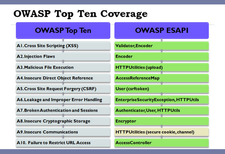ESAPI 1.4: Security Methods for the Web
The Enterprise Security API (ESAPI), a set of documentation focusing on application software security, has released a new version 1.4. Javadocs were updated and old interfaces were replaced.
ESAPI is a product of the Open Web Application Security Project (OWASP). The organization collects expertise on securing web applications, holds conferences and develops tools such as the WebScarab HTTP/S analysis proxy. OWASP members range from small consulting firms and security providers like Symantec to industry giants like IBM and Microsoft.
ESAPI describes methods that a typical web app needs for security. These methods include fixing authentication and protecting against cross-site scripting (XSS), cross-site request forgery (XSRF) and SQL injection. Other methods address failure to restrict URL access, insecure communications and improper error handling. The project publishes a Top 10 list of the most serious web app vulnerabilities.
The ESAPI project recommends that developers shouldn't continue to reinvent the security wheel for each application, but base their efforts on OWASP's expertise gained "over a decade of code review and penetration testing of critical enterprise applications."
The API is virtually independent of operating system and programming language, even though the current reference implementation is written in Java along with its Javadoc. Versions for .NET and PHP are planned.
ESAPI's Java implementation requires Java 1.4.2, but Java 1.6 users can uncomment code to make it work for them. The reference implementation is in binary JAR format for downloading. Developers will then have a forum in the OWASP-ESAPI mailing list.
Subscribe to our Linux Newsletters
Find Linux and Open Source Jobs
Subscribe to our ADMIN Newsletters
Support Our Work
Linux Magazine content is made possible with support from readers like you. Please consider contributing when you’ve found an article to be beneficial.

News
-
Fedora 43 Has Finally Landed
The Fedora Linux developers have announced their latest release, Fedora 43.
-
KDE Unleashes Plasma 6.5
The Plasma 6.5 desktop environment is now available with new features, improvements, and the usual bug fixes.
-
Xubuntu Site Possibly Hacked
It appears that the Xubuntu site was hacked and briefly served up a malicious ZIP file from its download page.
-
LMDE 7 Now Available
Linux Mint Debian Edition, version 7, has been officially released and is based on upstream Debian.
-
Linux Kernel 6.16 Reaches EOL
Linux kernel 6.16 has reached its end of life, which means you'll need to upgrade to the next stable release, Linux kernel 6.17.
-
Amazon Ditches Android for a Linux-Based OS
Amazon has migrated from Android to the Linux-based Vega OS for its Fire TV.
-
Cairo Dock 3.6 Now Available for More Compositors
If you're a fan of third-party desktop docks, then the latest release of Cairo Dock with Wayland support is for you.
-
System76 Unleashes Pop!_OS 24.04 Beta
System76's first beta of Pop!_OS 24.04 is an impressive feat.
-
Linux Kernel 6.17 is Available
Linus Torvalds has announced that the latest kernel has been released with plenty of core improvements and even more hardware support.
-
Kali Linux 2025.3 Released with New Hacking Tools
If you're a Kali Linux fan, you'll be glad to know that the third release of this famous pen-testing distribution is now available with updates for key components.

